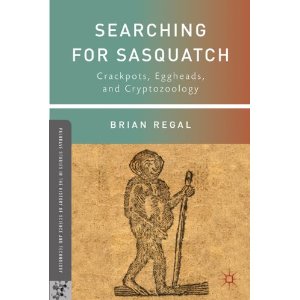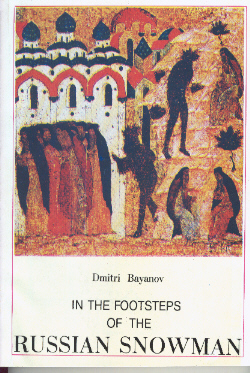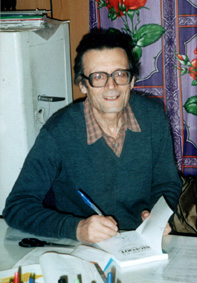
October 17, 2011

In 2011, there appeared a book entitled Searching for Sasquatch: Crackpots, Eggheads, and Cryptozoology by Brian Regal, from Palgrave Macmillan. It was clearly a skeptical debunker’s view of the world of hominology by an academic. Regal surfaced again last week, to address what he called the “shenanigans currently going on in Russia.”

Brian Regal
The article in The Guardian was headlined “Yeti hunters must be more scientific,” with a subheading, “Russian cryptozoologists claiming to have evidence of the yeti will never be taken seriously without a more academic approach.”
Among several statements, Regal shared these quoted thoughts: “A common complaint among cryptozoologists – those who pursue unknown or folkloric monsters – is that mainstream science does not take their work seriously and inappropriately labels it as pseudoscience.”
“One of the things the Russia monster project illuminates is the difference between science and pseudoscience: between real and fake science; between professional scientists and amateur investigators.”
“There are a number of cryptozoologists who work diligently at being properly scientific. They go about their work with intelligence as well as energy. While mostly amateurs, they embody the essence of the scientific endeavour: search the unknown. They, however, are regularly undermined by their less academic brethren. This condition shows that rather than mainstream science it is cryptozoologists themselves who often toss the monkey wrench (or should we say yeti wrench) into the works.”
“If the Yeti or Bigfoot or any of their kin do exist out there, someday they will be found, and likely by an amateur rather than a professional scientist. If that day arrives all of us sceptics will have to rethink our positions. Until then, if cryptozoologists want to be taken seriously by scientists they need to behave more like scientists and less like carnival barkers. Keep the circus to a minimum until you actually have a yeti to show the world, then respect will come.”
(The full article is available here.)


Dmitri Bayanov. Photo credit: Daniel Perez, 2001.
In rebuttal to Regal, Dmitri Bayanov of the International Center of Hominology in Moscow, Russia, has forwarded the following exclusively to Cryptomundo to be published as an answer to The Guardian piece:
++++++
Dr. Regal,
I am short of words to express how wrong I find your broadside published in The Guardian. It takes a specialist in meteoritics to verify whether a stone fell from heaven or is of earthly origin. It takes a paleontologist to verify a fossil. And it takes a hominologist to verify, for example, whether a subject on film is a Sasquatch or a disguised Homo sapiens. This follows from the fact that the Patterson-Gimlin documentary was labelled “fake” by anthropologists and zoologists, and proved authentic by hominologists (anyone who can prove that the label “fake” is correct will receive $100,000; see Bigfoot Research: The Russian Vision, 2011, p.152).
Conclusion: all non-hominologists, both scientists and laymen, are amateurs as regards hominology. Please take note of this: you and all scientists who have not devoted years to a study of our subject in depth are amateurs in hominology. Therefore your deliberations on our subject are pseudoscientific and putting things upside-down.
You pass it in silence that science, as taught by Thomas Kuhn, is divided into normal and revolutionary. “Normal science, for example, often suppresses fundamental novelties because they are necessarily subversive of its basic commitments” (Thomas Kuhn). A few illustrations of such suppression in our case:
Dr. John Bindernagel (Canada) , wildlife biologist, author of two books on the sasquatch, and a participant in what you dubbed “The shenanigans currently going on in Russia”, has this to say in his first book: “In my own case I used to be very concerned about how my interest in the sasquatch, if made public, would affect my reputation as a wildlife biologist, and hence my employability. When, after almost twenty-five years of research, I had reviewed enough evidence to be certain about the existence of the sasquatch, I finally came ‘out of the closet’ with my interest in this species. Long-standing concerns about keeping a low profile on the subject — which still surface in certain situations — keep me sensitive to the feelings of reluctant observers reported to have seen a sasquatch” (North America’s Great Ape: the Sasquatch, 1998, p.20).
Dr. Bindernagel’s present complaint is that he is denied possibilities of speaking publicly on our subject at mainstream science forums.

Dmitri Bayanov, John Green, and Grover Krantz at the Darwin Museum, October 1997, with an image of Bigfoot Bulletin editor George Haas.
The late Dr. Grover Krantz had also problems in his career because of his interest in sasquatchery. He wrote: “There are many younger scientists who are interested in sasquatch, though most of them are still keeping a low profile for now. (…) For now, one of my functions has been to serve as a role model for them, showing that one can get by with this kind of research. But I also show them the price that must be paid for doing it. (…) Back in 1970 I had only a rough idea of the trouble that could result from openly working on this subject, but I didn’t expect it to last more than a few years. My first shock was to be deferred on tenure for one year, in spite of the fact that I was already more frequently cited for normal work than most of the other members of the department. (…) Much later, when my promotion to full professor was denied, the only reason the dean could come up with was that my work was not favorably received in all quarters. (By this criterion, Charles Darwin and Albert Einstein could not possibly have gotten this promotion at my university). (…) Some of my colleagues have pointed out that if I just laid off the sasquatch and kept my ‘nose clean’ for a few years, the promotion would come through and then I could do anything I wanted. My response was that I am doing what I want right now, so the only thing that procedure would accomplish is to cost me a few years’ work” (Big Footprints, 1992, pp.240-42).
Dr. Jeff Meldrum has also known pressure of this kind. This is in largely democratic North America. As for the totalitarian Soviet Union, after the subverted and falsified 1958 Pamir expedition (Marie-Jeanne Koffmann has the full story), Boris Porshnev’s adversaries launched a counter-attack, scientific publication and mainstream forums became forbidden to us (remain so now), and Porshnev died of a heart attack when publication of his book was banned.
That’s what concerns relations with mainstream science. As to long-term witnesses, the BF contactees, the habituators and befrienders, who are the best hope for breakthroughs in hominology, they also experience grave problems from mysterious human attackers, who steal or destroy recorded evidence, vandalize the habituators’ property and disrupt friendly contacts with sasquatches. These shenanigans are described in some published books.
Such is the real picture and situation in and around hominology. It’s rather different from yours.The media hype and numerous hoaxes are the direct result of the abnormal, actually anti-scientific stance of the scientific establishment regarding this matter.There is definitely a taboo and cover-up at the highest level. To “keep the circus to a minimum”, or better put it to an end, the attitude of the scientific community to this subject must change radically.This can only happen if it’s provided with true information possessed by hominologists, instead of misinformation supplied by you and other non-hominologists.
The names you use (“monster enthusiast”, “monster hunters”, “monster project”) show your disrespectful and mocking attitude toward this most important subject. Thus you are more of a scoftic than skeptic. You have either to back up and substantiate your criticism with concrete arguments and examples regarding our research, including my books and articles, or pronounce “mea culpa”. To make your task easier, I offer here a link to my online article (“Thoughts on The Revolution in Anthropology“) and provide in attachment my address at the conference in the Darwin Museum, October 5. Please state what you find wanting or faulty in them. If you accept what I say there, peace can be restored.
Dmitri Bayanov
International Center of Hominology
Moscow, Russia
++++++++++
About Loren Coleman
Loren Coleman is one of the world’s leading cryptozoologists, some say “the” leading living cryptozoologist. Certainly, he is acknowledged as the current living American researcher and writer who has most popularized cryptozoology in the late 20th and early 21st centuries.
Starting his fieldwork and investigations in 1960, after traveling and trekking extensively in pursuit of cryptozoological mysteries, Coleman began writing to share his experiences in 1969. An honorary member of Ivan T. Sanderson’s Society for the Investigation of the Unexplained in the 1970s, Coleman has been bestowed with similar honorary memberships of the North Idaho College Cryptozoology Club in 1983, and in subsequent years, that of the British Columbia Scientific Cryptozoology Club, CryptoSafari International, and other international organizations. He was also a Life Member and Benefactor of the International Society of Cryptozoology (now-defunct).
Loren Coleman’s daily blog, as a member of the Cryptomundo Team, served as an ongoing avenue of communication for the ever-growing body of cryptozoo news from 2005 through 2013. He returned as an infrequent contributor beginning Halloween week of 2015.
Coleman is the founder in 2003, and current director of the International Cryptozoology Museum in Portland, Maine.
Filed under Abominable Snowman, Almas, Bigfoot, Breaking News, CryptoZoo News, Cryptozoologists, Sasquatch, Skeptical Discussions, Yeren, Yeti, Yowie